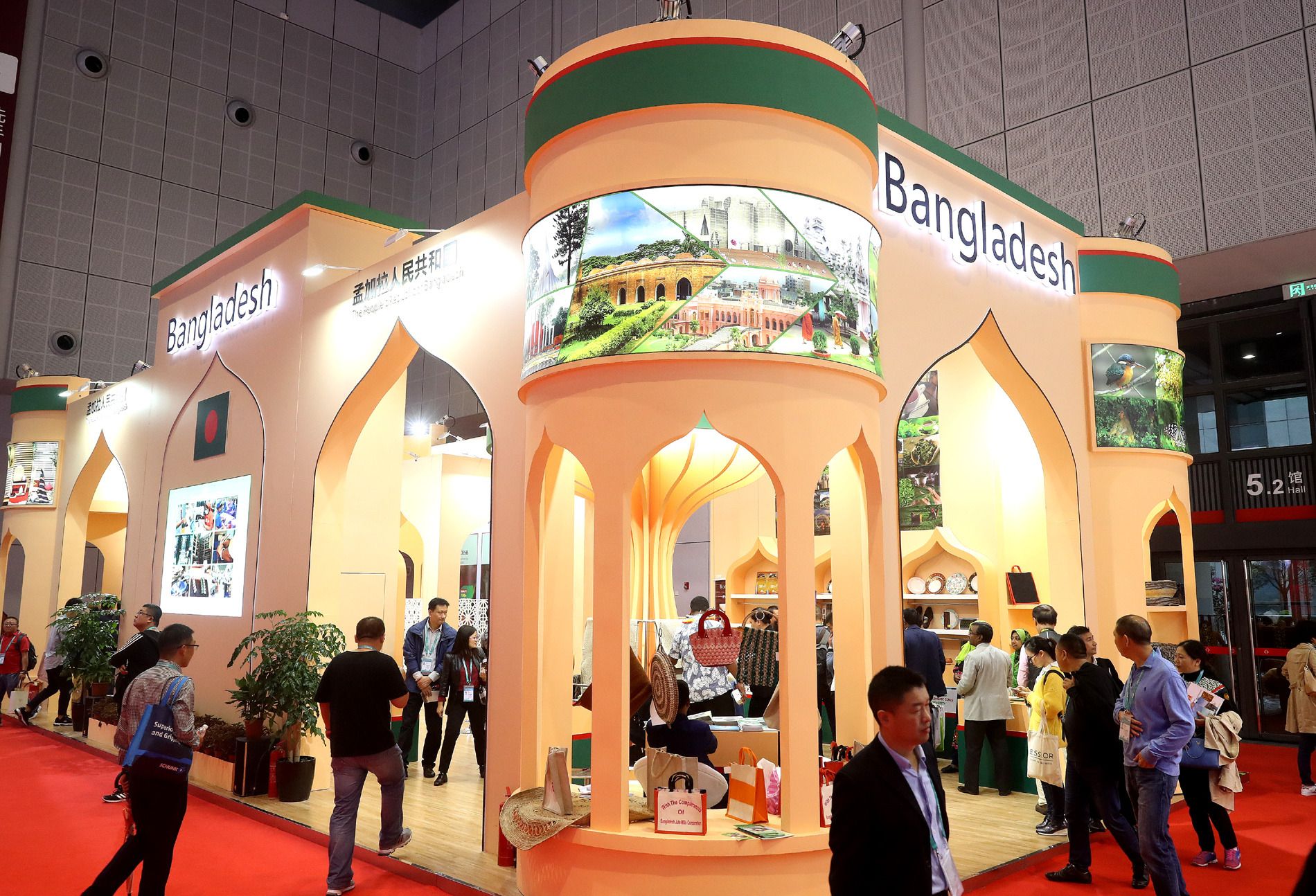Bangladesh’s Growing International Position: Opportunities for Poland

Economic Potential
Bangladesh is the eighth most-populous country in the world and one of the most densely populated. Its territory is half the size of Poland but inhabited by at least 160 million people (the latest official data from 2011). After the restoration of parliamentary democracy in 1991, the country has been developing dynamically, becoming an example of fighting poverty and improving living conditions. Since 2000, the number of people living in poverty has been cut by more than half, from 48.9% in 2000 to 21.9% in 2018. The average annual economic growth since 2002 has been 6.5% of GDP, and in 2019 was one of the highest in the world (7.9%). In 2015, Bangladesh left the category of Low Income Countries (LIC) and is on the way to exit the Least Developed Countries (LDC) group by 2024. The success of the last decades was determined primarily by political stability, openness to foreign investment, the development of the manufacturing sector (mainly textiles), and the strengthening of women’s rights. The current government’s ambition is to achieve the status of a developed country by 2041. However, structural economic problems and the COVID19 pandemic may stand in the way of achieving this goal.
Problems and Challenges
Despite the reforms undertaken, Bangladesh remains one of the most difficult places to do business. According to the World Bank’s 2020 ranking, it ranked 168th out of 190 classified economies. The poor condition of transport and energy infrastructure, complex regulations, and low-quality education may inhibit further rapid economic growth. To attract foreign investment, the government established a consolidated investor service (“one stop shop”) in 2017 and plans to open 100 special economic zones by 2030. However, a growing problem, especially for democratic countries, may be the deteriorating state of democracy. The last parliamentary elections in December 2018, won by the Bangladesh Awami League (with 78% of the vote), which has been ruling since 2008, are widely regarded as manipulated, and the government of Prime Minister Sheikh Hasina Wazed is accused of persecuting the opposition and restricting freedom of expression.
Today, the government’s priority will be to overcome the effects of the COVID-19 pandemic. As of 14 September, almost 338,000 infections were confirmed in the country and more than 4,700 people have died. The country’s lockdown introduced in March-May and the slowdown in the global economy seriously worsened the outlook for GDP growth. According to IMF economic forecasts from June, the country’s economy will slow in 2020 to 3.8% of GDP (against 7.6% expected in October 2019) and then return to a faster pace in the following years (5.7% in 2021 and 8% of GDP in 2022). Lower demand for export goods (mainly textiles) and a limited inflow of remittances from migrants (in 2018, they sent $15.5 billion to the country, which accounted for as much as 5.7% of GDP) will deepen the current account deficit and reduce needed investments .
Political and Strategic Potential
The growing engagement of China in South Asia, as well as the rising rivalry between the U.S. and China in Indo-Pacific, make Bangladesh strategically important for the major powers in the region: China, India, and the U.S. In 2016, the authorities established a strategic partnership with China and joined the Chinese Belt and Road Initiative (BRI). China has quickly become a major trading partner and source of foreign investment. Promised loans for projects amount to $38 billion (for example, building the largest span in the country, the Padma Bridge, worth $3.6 billion). To maintain traditional influence, India agreed in 2015 to settle a border dispute with Bangladesh, and in 2017 granted loans worth $4.5 billion for investments in the transport and energy networks.
In turn, the U.S. proposes deepened political, security, and military cooperation. This includes sales of American Apache helicopters and fighter planes, and in March the countries—together with the British—held the first trilateral military exercise in the Indian Ocean. Japan, Australia, and European countries also have strengthened their investments and development aid for Bangladesh. The EU remains an important partner of Bangladesh, it is the main source of development aid, the second-largest investor, and the largest export market (40%) for Bangladeshi products, which benefit from the EU’s system of trade preferences for the poorest countries.
Bangladesh also plays an important role in UN peacekeeping missions—it is the largest provider of personnel—and in fighting international terrorism and extremism. In climate negotiations, it is one of the countries most affected by climate change. Since 2017, it has provided shelter to almost one million Rohingya refugees expelled from Myanmar, which it cites in building its positive international image.
Polish-Bangladeshi Relations
Poland was one of the first countries to recognise Bangladesh’s independence in 1971 and diplomatic relations were established on 12 January 1972. However, after the reorientation of Polish foreign policy after the end of the Cold War, political contacts weakened, culminating in the closure of the Polish embassy in Dhaka in 2001. As a result, matters concerning one of the most populous countries in the world falls to the Polish embassy in New Delhi, located more than 2,000 km away, and which in addition covers Afghanistan, Sri Lanka, Nepal, Bhutan, and the Maldives. The Honorary Consul of the Republic of Poland in Dhaka deals with the daily promotion of Polish interests and care for Polish citizens. The lack of a permanent office means, however, less visibility for Poland and difficulties for Bangladeshi citizens seeking Polish visas.
Another manifestation of the low rank of relations after 1989 is the lack of top-level exchange visits. The intergovernmental dialogue at the level of deputy ministers was reactivated only in 2016. During the last visit of the Polish deputy minister of foreign affairs to Dhaka on 19 February 2020, an agreement on political consultations was signed and discussed that addressed prospects for cooperation in agriculture, defence, energy, and others. Both sides expressed their willingness to intensify relations and the political dialogue. Evidence of the revival of contacts includes the opening of the Bangladesh embassy in Warsaw in 2015 and the growing number of Bangladeshi citizens in Poland (over 1,500 in 2019).
Polish companies have been showing increasing interest in Bangladesh (mainly from the clothing and footwear industry) where they produce their products. Trade is growing: in 2019, it exceeded $2 billion, but it consists almost entirely of imports from Bangladesh (Polish exports amounted to only $67 million). The opportunity to improve the trade balance can be seen in the sale of equipment, technologies, and services for mining, energy, armaments, food processing, and environmental protection. It is also worth taking advantage of the fact that more and more Bangladeshi citizens travel abroad for tourism (2.6 million in 2019), for employment (about 1 million in 2019), or for studies (60,000 in 2017).
Conclusions and Recommendations
Although the COVID‑19 pandemic and the slowdown in globalisation processes will make it difficult to achieve development goals, Bangladesh has great potential to return to rapid growth. It may also benefit from the decline in international confidence in China as more companies seeking low labour costs may wish to move their production there. The authorities have so far been able to skilfully use the rivalry of powers in the region to Bangladesh’s advantage, and this situation creates additional opportunities for the country’s future development. Unless the democratic system is further limited, the EU will also increase its involvement there.
The growing strategic importance and great economic potential of Bangladesh require the revival of Polish-Bangladeshi cooperation. This would be achieved by re-opening the Polish embassy in Dhaka, which would improve Poland’s visibility, and by deepening the political dialogue, including meetings of foreign ministers and visits at the highest level. The opening of a foreign trade office of the Polish Trade and Investment Agency in Dhaka would also be helpful for Polish companies in entering this difficult market. A positive signal strengthening political cooperation would be, for example, diplomatic support of Bangladesh’s proposal regarding the safe repatriation of Rohingya to Myanmar, in line with the principle emphasised by Poland of its commitment to compliance with international law.


